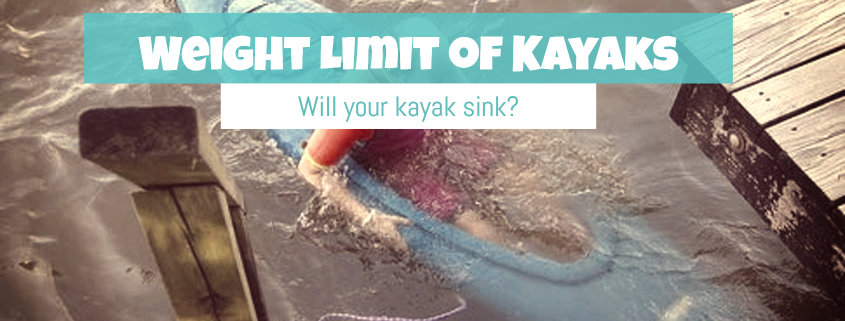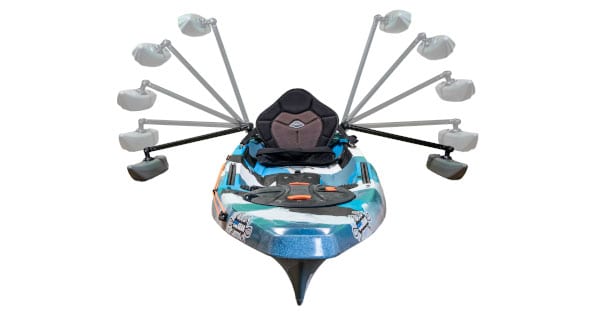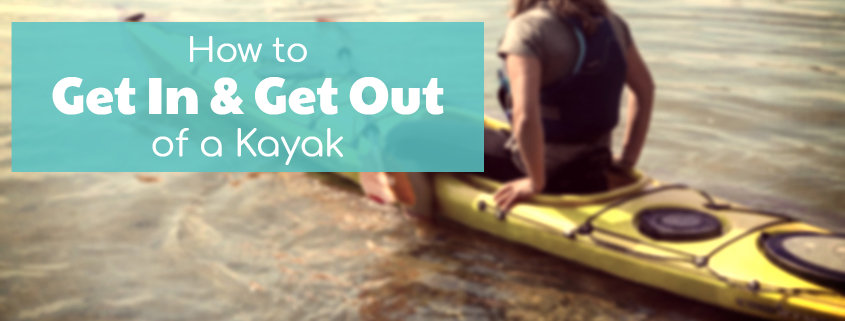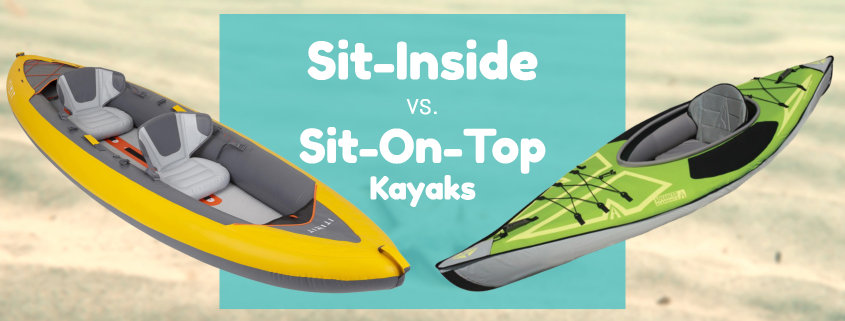One of the factors to consider when buying a kayak is its weight limit.
Every kayak has a maximum weight capacity, which varies by type of kayak and manufacturer.
Making sure your kayak can support your weight and payload will make your time paddling easier, more fun, and safer.
Here is everything you need to know about the weight limit of a kayak.
Contents
The weight limit of kayaks explained
Every kayak on the market has a weight limit assigned by the manufacturer.
This means that to keep the kayak afloat, the weight of the paddler and gear should be below the maximum weight capacity.
Even though there is no industry norm, the weight limit is calculated based on the length, width and water displacement volume of the kayak.
Can you load a kayak to its full weight limit though?
Theoretically yes, but it is not a good idea at all.
The kayak will stay afloat, but it will:
- Be very low in the water
- Lose maneuverability
- Lose stability
- Be difficult to paddle
- Be difficult to stay dry
With a cockpit-style kayak, you will splash water into the kayak with each stroke, putting even more weight into it. On a sit-on-top kayak, you would just be at the waterline with most of the boat under the water.
Check out this video to see what happens with an overloaded kayak.
Not fun to paddle at all.
Kayak weight limit for optimal performance
Now that you know why you shouldn’t max out your kayaks weight limit, let’s talk about how much weight you can put into it.
Some manufacturers have started displaying a “performance weight limit” as well as the standard “safety weight limit” on their kayaks.
The rule of thumb for optimal paddling is to max out your load at:
35% less than maximum capacity
If you want to achieve peak performance from your kayak, you should keep the weight of everything in the kayak at least 35% lower than its official safe capacity. 50% is even better.
This includes the weight of the paddler plus that of all the gear in the kayak (paddles, clothing, shoes, and all other equipment).
Here is the formula for the performance weight limit of a kayak:
Performance weight limit = safety weight limit x 0.65
Here is a table to break this down with the most common weight limitations.
| Official weight limit | Optimal capacity (%35 less) |
|---|---|
| 300 lbs (136 kg) | 195 lbs (88 kg) |
| 400 lbs (181 kg) | 260 lbs (117 kg) |
| 450 lbs (204 kg) | 292 lbs (132 kg) |
| 500 lbs (227 kg) | 325 lbs (146 kg) |
| 550 lbs (250 kg) | 357 lbs (161 kg) |
| 600 lbs (272 kg) | 390 lbs (175 kg) |
| 650 lbs (295 kg) | 422 lbs (190 kg) |
It might seem strange that you can only use 65% of the capacity of your kayak, but believe me: if you pay attention to this, your kayaking experience will be much more enjoyable.
It will be easier to paddle and maneuver your boat if you keep your weight at under the 65% mark.
Average weight limit of kayaks
Keeping in mind that the maximum capacity of a kayak is not the optimal capacity, let’s have a quick look at what the weight limits of various kayak types are.
Recreational kayaks: 250 – 300 lbs weight limit
Recreational kayaks are designed for casual paddling to be used on flat waters such slow-moving rivers, streams, or lakes. They are not intended for use in whitewater, or out on the sea or ocean. Bad weather with lots of wind is also a problem for recreational kayaks.
These kayaks will be between 10-15 feet long and have large cockpits which make getting in and out easy.
Here are 2 great recreational kayaks.
Sun Dolphin Aruba 10
- Length: 10′
- Capacity: 250 lbs
Ocean Kayak Tetra
- Length: 10.5′
- Capacity: 300 lbs
Touring kayaks: 300 – 350 lbs weight limit
Touring kayaks are also called expedition kayaks. They are designed for trips that last several days, just the opposite of recreational kayaks. They are suitable for use in turbulent water and windy weather. Touring kayaks are very stable even out in the open sea, making them great sea kayaks. Remember to adhere to safety advice when kayaking on open water.
Since they are designed for multi-day trips, they have a larger storage capacity and space to stow all the gear you need to take (tent, sleeping bag, food, etc.).
Here are some good quality touring kayaks.
Pelican Premium Sprint 140DT
- Length: 14′
- Capacity: 300 lbs
Perception Carolina 14
- Length: 14′
- Capacity: 300 lbs
Sit on top kayaks: 325 – 400 lbs weight limit
Sit on top kayaks are very stable and easy to enter/exit, making them perfect for beginners and children. They are slower than cockpit-style kayaks, and are intended for calm water and weather.
They are approximately 10-15 feet long and are wider than other kayak types, which gives them the added stability.
These sit on top kayaks are safe and durable.
Perception Pescador Pro 10
- Length: 10.5′
- Capacity: 325 lbs
Wilderness Systems Tarpon 120
- Length: 12′
- Capacity: 350 lbs
Tandem kayaks: 500 – 600 lbs weight limit
Tandem kayaks are intended for use by multiple paddlers. They are longer and usually wider than single-seat kayaks, making them useful not just as a recreational boat, but also for longer trips.
Their wide body makes them very stable. They are mostly 14 to 18 feet long and have the highest weight capacity of all kayaks. This combination of room and stability makes them very popular.
Here are some good tandem kayaks.
Ocean Kayak Malibu Two XL
- Length: 13.3′
- Capacity: 500 lbs
Perception Rambler 13.5
- Length: 13.5′
- Capacity: 550 lbs
Inflatable kayaks: 400-750 lbs weight limit
Inflatable kayaks have a larger weight limit as compared to hard-shell kayaks, thanks to the buoyancy provided by the air-filled tubes.
Most inflatable kayaks have a capacity of more than 500 lbs, but you can even find some with a 750 lbs limit.
They are also wider than hard shell kayaks, making them more stable out on the water.
If you’re looking for a kayak for big guys, you should definitely consider inflatable kayaks. They have the capacity and stability to handle the weight of big guys and their gear.
Here is an article comparing hard-shell vs inflatable kayaks.
Here are various inflatable kayaks.
Sea Eagle 370 PRO
- Length: 12.5′
- Capacity: 650 lbs
Advanced Elements Expedition
- Length: 15′
- Capacity: 550 lbs
Can you increase the weight capacity of a kayak?
As you already know, the capacity of your kayak is a function of the length, width, and volume of your kayak.
There is no 100% working way to increase the weight of your kayak, without modifying its hull.
The only way I’ve heard that may work is by fitting outriggers like these to your hard-shell kayak. I have not tried this though, so no personal experience.
This will cause extra drag and sacrifice maneuverability, but add stability. I am doubtful whether it can really increase the capacity of your boat though, since it would have to rigidly immerse below your boat’s hull to do so.
So if you want to load more weight into your kayak, your best bet is to sell yours and get a bigger one.
FAQ
Here are some of the most asked questions pertaining to the weight limit of kayaks and canoes. If you have any other questions, let me know in the comments.
What size kayak is best for my height?
The more weight you have higher up, the higher your center of gravity will be, which makes the kayak/canoe feel tippier. If you are tall, look for kayaks that have a wider base. The wider the base, the stabler the kayak.
Inflatable kayaks tend to be very stable and are a great choice for tall paddlers.
If you are short, you don’t need to worry about this aspect of choosing a kayak or canoe.
Where should the heavier person sit in a kayak/canoe?
The heavier person should generally sit in the back when paddling tandem.
Here is a detailed article explaining where you should sit in a tandem kayak.
Are shorter or longer kayaks better?
Both short and long kayaks have their respective pros and cons.
Shorter kayaks are 8-12 feet long. They turn more easily and are easier to transport. They are generally less expensive as well.
Longer kayaks are more than 12 feet long. They track straighter and are faster, meaning they require less effort on longer trips on flat rivers and lakes.
Can you kayak if you are overweight?
Yes of course, just take note of the optimal weight limit of the kayak and the cockpit size. A 6 foot, 300 lbs man will probably fit into all kayak cockpits.
You can also opt for a sit on top kayak, which has no cabin to fit into.
Also, tandem kayaks typically have a larger cockpit.
Will I fit into the kayak?
Sit on top or cockpit-style recreational kayaks are designed for a comfortable fit. You should be able to move around comfortably, even if you are overweight.
Whitewater kayaks have smaller cockpit openings, as they are intended to be snug fitting.







Hi. I’m 5’8″ 220 lbs and used a 8 ft Sundolphin before no problem. Never felt tippy. I now Have a 8 ft Pelican Potomic. It is built Better and feels more stable. Used on local lakes. It says it’s rated for 200 lbs. But I don’t see why. I’ve never felt uncomfortable using it. By your calculations I should be using a 12 footer. I wear my life jacket of course but I’m completely comfortable.
Hi there, the calculation is for optimal performance, it doesn’t mean you’ll sink like a rock 🙂 If you try another kayak that has a higher capacity, so you are still within the optimal performance parameter, you’ll feel the difference in paddling.
Hello,
Thank you for great information for starters:)
My question: I’m 5′ 10″. 240lbs. I’ve been wanting an Intex Excursion Pro inflatable kayak to fish with. The single seat version is only rated for 220lbs. Will it still hold me, or do I need to ‘spend up’ to get the larger 2 seat version?
I wasn’t sure how much leeway they put into that calculation.
Thank you for any information you can give.
Jack
Hi Jack,
It won’t sink, but it will sag under you. I’m not sure the longer one would be much better, since it only has I-tubes as well.
In this price range, you should get the Sea Eagle 330/370 instead, I wrote about it here.